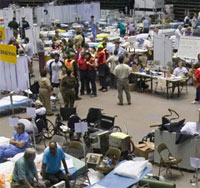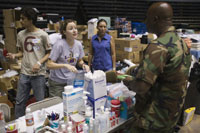IN THIS ISSUE
FROM THE TOP
NEED TO KNOW
WHO'S WHERE
PAST ISSUES
From the Top
From the Edge of
Katrina: An Update and Thoughts
on the Future of IT Planning for Disaster Recovery
By Brian D. Voss,
CIO,
Louisiana State University

About two months ago, I wrote a piece, Hitting
the Ground Walking for C2 about my experiences as a new CIO. Today, in the
aftermath of Katrina, I have to say that I no longer feel like a newbie. And
I say that, having had the good fortune of not having to confront the horrors
and challenges faced today and in the days ahead, by my colleagues at
Tulane,
University of New Orleans, Xavier, Loyola, and other New Orleans-based institutions.
As I write this, I'm mindful that we have not yet heard all their stories, as
they have been too busy dealing with their burdens and losses to even sit down
and write something.
They are dealing with the prototypical disaster recovery scenario. I am not.
My data center was untouched after the storm passed us that Monday afternoon.
The center was running on a newly repaired back-up generator (I'm glad we found
and fixed a problem there a week before) and many of our systems were powered
down to conserve fuel for the first 36 hours after Katrina passed. But everything
was fine. We were even running our new HPC resource at the limit, as researchers
here were analyzing storm data.
Then a new reality set in, as New Orleans flooded the following morning. Everything
I thought I was going to be doing as CIO has changed. I am not recovering from
a disaster to my facility. But I have been dealing with the aftermath of the
worst disaster in our nation's history. Let me tell you a little bit about how
things played out, and continue to play out for us, here on the outskirts of
this disaster. Then I'd like to share some early thoughts about the future of
disaster recovery planning in higher education.

In the days immediately after Katrina's passing, the LSU A&M campus in
Baton Rouge became a primary location for medical evacuations. Our Pete Maravich
Assembly Center (PMAC) and its neighboring Field House became a M*A*S*H-like
triage center and special needs facility respectively. I'm told that it is the
largest such facility ever assembled in time of disaster in the U.S. and it
handled more than 5,000 patients in the early days after the disaster. Emergency
response units sprang up on campus from the alphabet soup of agencies, both
state and national, as did volunteer coordination centers. LSU became the primary
operations point for these immediate response needs, and with that the university's
role shifted from a higher education focus to one of higher calling. Helicopters
buzzing overhead became a common occurrence; we didn't even look up at them
anymore. Sirens no longer alarmed us; we heard them constantly. And campus streets
weren't teaming with students; streets that weren't disturbingly silent were
disturbingly filled with uniformed men, medical teams, and volunteers streaming
to the aid of the sick, wounded, and displaced.
Having lived through the past several days (it seems much, much longer), I
am simply amazed by my colleagues on campus, and how they performed. There are
many exhausted her'es who the week before were ordinary women and men serving
higher education at Louisiana's flagship institution. They responded-they improvised,
adapted, and overcame. They didn't have a book or manual to follow. One of them
said it best: "We're not following the book here, we're writing it."
(Photos courtsey of LSU)
Read
More | Send
Comment | Back to
top
Need to Know
Tulane's President Chats to Calm Concerns
From temporary headquarters in Houston, President Scott Cowen is answering
the Tulane University (LA) community’s questions about
post-Katrina operations directly, through Friday afternoon chat sessions.
During the first session, held this past week (courtesy LiveWorld, www.liveworld.com),
students, parents, faculty, and staff asked about everything from tuition
reimbursement to the status and accessibility of research facilities.
(The weekly chats are now being offered in addition to the temporary
Web site (www.tulane.edu) on
which the university began posting critical information as the disaster
unfolded in the region, plus other communications such as a telephone
Alert Line and an “asktu” e-mail address.) While Tulane was not as badly
damaged as surrounding areas, safe and normal operations are dependent
on water, sewer, and other services in the region, so the university
will remain closed until the Spring semester. Meanwhile, restoring IT
is high on the list of Tulane’s priorities. President Cowen said during
Friday’s chat, “We’re in the process of bringing up our IT systems as
I speak. We have established a clear order of priority. We anticipate
it will still be several weeks before our normal Web mail will be available.
At this time it is much more important for us to be able to access our
payroll systems, student information systems, and financial systems.”
Other key staff will join President Cowen in future chats, to help continue
the tremendous effort to keep far-flung Tulanians well-informed as the
university progresses toward an expected January reopening.
Pocket PC Phones at Wake Forest
MobileU, a pilot program launched this term at Wake Forest
University (NC) will explore the use of the converged PDA/phone
devices with about 100 students and staff. “What we’ve seen
over the past two or three years is students moving away from more traditional
messaging like e-mail to newer technologies such as instant messaging
and text messaging,” says Jay Dominick, Wake Forest’s CIO.
“Student communication patterns are diverging. We want to find
out if we can use mobile technology to close that gap, to deliver new
things in ways students want to get them.” Find
out more.
Portfolio Partners
Open source provider rSmart has announced the immediate availability
of the rSmart/IBM Appliance for Education, a bundling of rSmart ePortfolio
with IBM’s Websphere software and Db2 database. “Most educational
institutions have come to recognize the benefits of ePortfolio, but
its complex nature has left many wondering how it can best be introduced
and implemented,” says Ray Barker, CEO of rSmart. “The rSmart/IBM
appliance helps to make ePortfolio more useful and more accessible to
all educational institutions.” Find
out more.
| Send
Comment | Back to
top
Who's Where
UCLA Chancellor Plans to Step Down
Albert Carnesale, UCLA chancellor since 1997, has announced plans
to leave his post as chancellor and return to teaching, public policy,
and international affairs after a sabbatical leave which begins in June,
2006. Carnesale holds professorial appointments in UCLA’s School
of Public Affairs and the Henry Samueli School of Engineering and Applied
Science, is a member of the American Academy of Arts and Sciences and
of the Council on Foreign Relations, and is a lecturer and author. Find
out more.
| Send
Comment | Back to
top